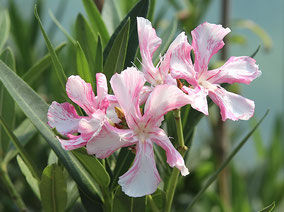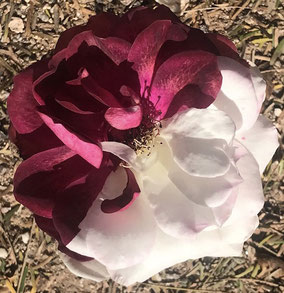- DEUTSCH
- ENGLISH
- SUCHE / SEARCH
Kewpie - a Chimera
The concept of a chimera is known from Greek mythology. A chimera is a “hybrid creature”; this means that a being is composed of two or more different ones. (Wikipedia) The Greek word means “goat”. We know of other hybrid creatures, e.g. the Minotaur, the Sphinx, the centaur, the basilisk and others. But these all belong to the realm of mythology. There, the meaning is easy to understand and is portrayed particularly vividly in illustrations.
Chimeras also exist in the plant kingdom. One type of chimera formation is even generally well-known, as it is used in horticulture as a standard method of improving fruit trees (and also certain types of vegetables). We are referring to “grafting”. This consists of an underlying “stock” having a corresponding “scion” grafted onto it. Two different plant parts are connected to form a single organism.
(Wikipedia: Grafting) This is done artificially by hand, and the grafted joints, where the two differing plant tissues were bound together, are usually (on fruit trees) quite visible years later.
And then there are chimeras – we’re still in the plant world – in which the differing parts of one plant are not apparent at first glance, as there is no visible line of demarcation. Here, the whole plant, the entire organism, is composed of genetically different cells or cell tissues, thus structured considerably smaller. So as not to get too technical here, we refer you again to Wikipedia. Chimeras which come into being in this form naturally are rather rare.
And with this, we come to Kewpie.
To say it right up front: we look admiringly at the variegated, pink and white striped blossom. However, the essential thing actually is that on the same bush, on the same twig, in a neighboring inflorescence, indeed even in the same inflorescence, differing blossoms can be formed; namely the clearly original single pink sort and the new striped form. This new, spectacular blossom itself is not the chimera; it is just the result of the formation of a chimera. The chimera itself is the total organism, comprised of genetically different cells within its tissues. It is perhaps by luck or by chance that the plant, either as a relic or as evidence – still produces the earlier single pink blossom from its differentiated cell tissues. Are the stripes on individual petals of the typical Kewpie blossom also traceable to differing cells within the cell tissue and thus proof of the chimera formation? Only laboratory gene analysis would be able to provide clarity here.
It’s reported that efforts were made to secure the striped form of the blossom by taking cuttings only from those twigs that showed this trait. However, even after many generations of such cuttings, the single pink flower continues to turn up. This is the reason for the assumption that both differing “beings” of the complete organism are present in the cell tissue itself.
The Variability in Flower Shape and Color.
This is what the classic ‘Kewpie’ looks like, large pinwheel-shaped blossoms, the petals narrow and spiralling outward, with pronounced variegation (pink and white striped).
It can also look different, however: The striping remains, the corona type is the same, but the blossoms are rounder; no longer like pinwheels. But we can still easily recognize ‘Kewpie’.
If we didn’t know that we were looking at ‘Kewpie’, or if these flowers were not on the same bush or on the same branch, we could easily believe, at first glance, that this is simply a pink oleander. But they are, in fact, Kewpie blossoms; ‘the other Kewpie blossoms’, the chimeric blossoms which are derived from the other cell tissue.
The third photo shows a mixed form; it looks like ‘Kewpie’ with regard to its shape, but is just a solid pink.
In general, one must say about the color pink, with regard to ‘Kewpie’, that it is a pink which tends toward magenta.
Photos from June 2021
The “chimera phenomenon” with regard to the oleander ‘Kewpie’ is demonstrated here on one and the same plant. Two inflorescences have produced diverse flower forms on the same twig of one plant during the same time period.
The third photo, June 9, 2021: Both inflorescences are in full bloom here. They are located on the same twig of the same plant. It is also apparent that the shape of the flower has changed as the days have gone by. At first, the blossoms are rounded; after one to several days, the petals take on the characteristic rolled form.
It’s also interesting that the pink blossoms appeared on an inflorescence which developed this year; however, the striped blossoms are on an inflorescence which had already started to grow during the previous autumn and which persisted through the winter season.
This photo of a Kewpie blossom merits special attention and probably has value as a rarity.
It is, so to speak, the ‘missing link’ in the chainof the possible genetic alterations in the common cell tissue. The single pink-blooming form on one shrub – on one twig – in one inflorescence – as an individual blossom – and here in one flower, one petal (and perhaps) even to the individual stripes wihtin one single petal.
Photo: Barry Landry, Galveston.
Sources regarding Kewpie, to date.
Elizabeth Head, president of the International Oleander Society/Galveston for many years, was able to assess the unique character of the new oleander cultivar as a ‘chimera’ (The Story of ‘Kewpie’, Elizabeth Head):
". . .We were told that we would need to propagate about 4 different consecutive propagations to be sure that the variety would be a permanent variety and not revert back to its (?) original form since it did show some plain and some variegated flowers. We always chose the plants that retained the most variations [sic] and so decided after a lot of propagations that it seemed to be permanent. We have found that some bushes as the years have gone along would have more plain blossoms than others. We always tried to take the one with the most when we grew some new ones. It could well have been a chimera also that caused it to change. . ."
In the book ‘The Handbook on Oleanders’, by Richard & Mary Helen Eggenberger‘ (The Story of Kewpie, Eggenberger) the story of the ‘unusual plant’ is told: ". . .The flowers were pink with some blossoms strongly variegated; one branch consistently produced flowers that were all variegated. This sport was rooted and named in honor of Mrs. Kewpie Gaido. It is a large pinwheel-shaped flower, variegated pink and white. . ."
Indeed, one can infer from the text that two oleander varieties were united in one plant; the word ‘chimera’, however, is not explicitly mentioned.
Other examples of ‘chimeras’.
Robert Newding, International Oleander Society/Galveston, explained that the oleander which he discovered in his garden in Galveston and named ‘Harriet Newding’ is a chimera. (The Story of Kewpie, Newding). That is, the plant is by its nature genetically unstable. At any time and on any part of the shrub, even on the same twig, the flowers may appear different than the well-known variegated ones.
Photo: Mrs. Milei Krisztina Horváth
'Laburnocytisus 'Adamii'
Broom and laburnum together form a chimera.
Actually, in this case it was artificially produced by an experiment in grafting.
Detailed description: wikipedia
Unusual stripe on an apple.
At harvest time, chimeras appear again and again on fruits.
From: Wochenblatt, Landwirtschaftsverlag GmbH, Dr. Helga Buchter-Weisbrodt
A listing of links regarding mutations and chimeras.
Abitur-wissen.org/index.php/biologie/genetik/362-genetik-chimaere
Wissenschaft-im-dialog.de/projekte/wieso/artikel/beitrag/wie-entsteht-eine-chimaere-bei-pflanzen
In vitro separation of a rose chimera:
Researchgate.net/publication/225614770_In_vitro_separation_of_a_rose_chimera
January 2021, July 2021, Oleander Haus, Translation: James Nicholas





















